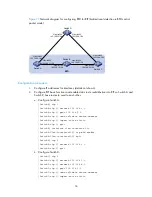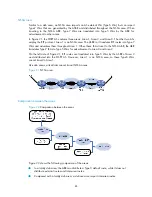
82
•
NSSA LSA: Type-7 LSA, as defined in RFC 1587, originated by ASBRs in NSSAs and
flooded throughout a single NSSA. NSSA LSAs describe routes to other ASs.
•
Opaque LSA: A proposed type of LSA, the format consisting of a standard LSA header and
application specific information. Opaque LSAs are used by the OSPF protocol or by some
application to distribute information into the OSPF routing domain. The opaque LSA includes
three types, Type 9, Type 10, and Type 11, which are used to flood into different areas. The
Type 9 opaque LSA is flooded into the local subnet, the Type 10 is flooded into the local
area, and the Type 11 is flooded throughout the AS.
Neighbor and adjacency
In OSPF,
Neighbor
and
Adjacency
are different concepts.
Neighbor: After startup, OSPF sends a hello packet on each OSPF interface. A router that
receives the hello packet checks parameters in the packet. If the parameters match its own, the
router considers the sending router an OSPF neighbor.
Adjacency: Two OSPF neighbors establish an adjacency relationship to synchronize their LSDBs.
Any two neighbors not exchanging route information will not establish an adjacency.
OSPF area partition
Area partition
When a large number of OSPF routers are present on a network, LSDBs may become so large
that a great amount of storage space is occupied, and CPU resources are exhausted by
performing SPF computation.
In addition, as the topology of a large network is prone to changes, enormous OSPF packets may
be created, reducing bandwidth utilization. Each topology change makes all routers perform
route calculation.
To solve this problem, OSPF splits an AS into multiple areas, which are identified by area ID. The
boundaries between areas are routers rather than links. A network segment (or a link) can only
reside in one area, which means, an OSPF interface must be specified to belong to its attached
Summary of Contents for S9500E Series
Page 435: ...435 ...
















































